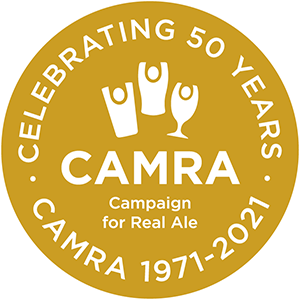Grapes
Greater Manchester - Peel Green
Three star - A pub interior of outstanding national historic importance
Listed Status: II
439 Liverpool RoadPeel Green
M30 7HD
Tel: (0161) 789 6971
Website https://www.joseph-holt.com/pubs/grapes
Facebook https://www.facebook.com/TheGrapes.PeelGreen
Real Ale: Yes
Nearby Station: Patricroft
Station Distance: 800m
Public Transport: Near Railway Station (Patricroft) and Bus Stop
Bus: Yes
View on: Whatpub
Entrance lobby with door to vault to right, ahead a full height mahogany screen with glazed panels and overlights and a door with cut and etched glass with vine designs and the words 'Grapes Hotel'. There are multiple star bursts and bevelled panels in the door and side panels in inner door. Through the door is one of the most impressive drinking passage in the UK. It has a high ceiling, a terrazzo floor, dado of green glazed tiles including some with Art Nouveau patterns which continues up the open staircase, elaborate mahogany Jacobean-style stair, elaborate bar with brilliant cut glass hatches and overlights.
On the right hand side of the passageway is a wonderful mahogany shuttered bar with sliding screens of deep cut glass panels in a fan shape with the top section almost reaching the ceiling. The first part of the screen has, unusually, no servery beyond it, but part of the Vault indicating the counter in the Vault is a much reduced size than the original. The upper rising panels in the screen remain. Similar screen opposite the staircase also retains its rising panels where customers are served and there are two small hatches where the upper panels also survive.
The Bar Parlour on the left has a Jacobean style door surround, door with cut and etched glass with the words "BAR PARLOUR", original fixed seating, bell pushes, baffles by the door with stained and leaded panels in the top and tiled & carved wood surround fireplace. Between the Bar Parlour and the Smoke Room is a terrazzo floor passage with dark green tiled dado which runs from the lobby to the door on the left hand side of the building. By the door there is a hatch in the wall on the smoke room side – was this the off sales?
The rear Smoke Room has a Jacobean style door surround, door with cut and etched glass with the words "SMOKE ROOM” and grape symbols with a panel in the top………. , a draught screen by the door with a stained and leaded panel in the top, another heavily carved mahogany surround fireplace with a tiled interior; the fixed seating here looks modern. In 19XX the rear wall was removed to combine it with a former private room at the rear so it is now doubled in size and has more modern fixed seating and no fireplace.
At the rear right twin doors with ‘Billiards’ and symbols and ‘Room’ and symbols with two glazed panels in the top with grapes symbols. The billiard room retains the seating on a raised platform on the exterior side and rear of the room but none either side of the impressive Jacobean style mahogany chimneypiece with pilasters with capitals and a ceramic interior and it rises to two-thirds the height of the ceiling. There are bell pushes in the panels at the end of the seating and another two along it. The end pieces of the raised fixed seating still have the makers labels ‘Pearson & Brown Manufacturers Contractors to H M Government, Eccles New Road, Weastle, Manchester’. The draught screen on the right has a stained and leaded panel in the top. A former exterior door is now the darts area. A pool table has replaced the full sized billiard one. The billiard room is served by a hatch which looks a later addition – the folding doors in it are definitely modern.
The gents’ here has 1920s ‘Gentlemen’ in the door, a dado of 1920/1930s tiles in yellow and green with decorative brown and a row of narrow green tiles at the top throughout the toilets. It is situated in an early 20th century flat roofed extension at the side and rear of the building. At the end of the lobby an original mahogany arch doorway to the rear of the smoke room and a smoking shelter. There is a door to the kitchen – was this a toilet originally?
On the front right is the Vault which has seen much change. The off-sales was absorbed some years ago and has a good but disused vestibule entrance with cut and etched glass; bar counter and simple fixed seating are all modern.
Upstairs is a meeting room with a ‘Club Room’ cut and etched glass panel in the door and an original tiled and carved wood surround fireplace. The small bar was added in the 1970s. The club room has a Baronial-style vaulted ceiling with exposed roof timbers and was used by the Royal and Ancient Order of Buffaloes. There is a small store room off it.
There have been some minor alterations over the years but the pub has such grandness and wealth of detail that the changes are not that apparent.
 Pub Heritage
Pub Heritage 